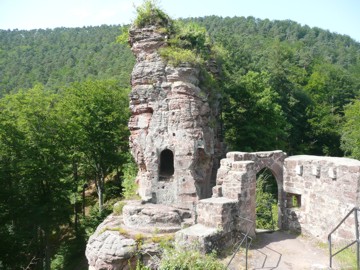

Location: Lembach in the Bas- Rhine department Map
The Château de Frœnsbourg, also known as Frœnsbourg Castle or Freundsberg, is a medieval ruined castle located in the Vosges du Nord Regional Nature Park in northeastern France. It exemplifies the region's rock castles, built into sandstone formations, and serves as a testament to the feudal history of Alsace. Classified as a historical monument since 1898, it attracts hikers and history enthusiasts despite its remote and rugged setting.
Situated in the Bas-Rhin department of the Grand Est region (formerly Alsace), the château lies northwest of the town of Lembach, near the village of Niedersteinbach. Its precise coordinates are approximately 49°02'13"N 7°44'35"E. The site is perched on an isolated sandstone spur in the forested hills of the Northern Vosges, oriented north-south and separated from the surrounding mountain by a large artificial ditch. Access is via hiking trails, such as the GR53 long-distance path or trails marked by the Club Vosgien (a blue rectangle symbol), starting from points like the Fleckenstein pond or the Froensbourg farm along the D3 road. The walk to the castle typically takes about 20 minutes on an easy forest path, followed by a steeper climb to the ruins themselves.
The château’s origins trace back to the 13th century,
with the first indirect mention in 1235 and a direct attestation in
1269, linked to the "brothers of Frundsperg" (Froensbourg), likely a
branch of the powerful Fleckenstein family, as they shared the same coat
of arms. Initially owned solely by the Froensbourg lords until the
1340s, it was later divided among the Froensbourg, Loewenstein, and
Sickingen families. In 1349, the castle became a notorious bandit lair
under Reinhard von Sickingen, leading to a siege and its partial
destruction. It was rebuilt after 1358, when the Loewenstein brothers
offered it as a fief to the Palatine Count Rupert I, only to be
destroyed again in 1359 by the Bishop of Strasbourg.
By the late
14th century, it was reconstructed, with further restorations in 1389 by
Emich and Sygfrid de Loewenstein as a Palatine fief. In the late 15th
century, ownership shifted to the Fleckensteins, who restored the
southern section around 1481 (evidenced by a dated Gothic doorway) and
the entire structure by 1484. The castle served as a fortress during
this period but was ultimately dismantled and destroyed in 1677 by
French troops under Louis XIV during the Dutch War, likely after it had
already been abandoned. Today, it is state-owned property, with no
records of significant post-17th-century use or reconstruction.
Notable events include its role in regional feudal conflicts and its
brief stint as a bandit hideout, which contributed to its ruin in 1349.
There are no widely documented legends associated with the château, such
as ghosts or mythical tales, though its dramatic, cliffside location and
history of sieges evoke a sense of medieval intrigue. Some sources
speculate on earlier constructions, with one suggesting a possible
founding around 1227 by Hugo de Rothenbourg, but this appears
conflicting and may refer to nearby sites; the Froensbourg lineage from
the Fleckensteins remains the consensus.
The Château de Frœnsbourg is a prime example of a
semi-troglodytic (rock-hewn) castle, ingeniously integrated into a
bifurcated sandstone outcrop divided into two autonomous sections: a
larger northern rock (the "big castle") and a smaller southern rock (the
"small castle"). The northern section features a keep with adjoining
living quarters, common buildings, and dependencies—many originally
wooden, as indicated by surviving anchor points in the rock. Troglodytic
elements include rooms carved directly into the cliff, such as a stable,
a well-cistern at the base (possibly an old drawbridge-accessed
chamber), and multiple rock-cut staircases, including a winding one on a
western projection.
The southern rock houses the remnants of a
dwelling tower with a distinctive Gothic arched doorway inscribed with
the year 1481. The two rocks were historically separated but are now
connected by a modern footbridge at mid-level for visitor access.
Innovative features include a wheel system used to hoist provisions and
materials up the steep rock faces, facilitating construction and daily
life in this elevated fortress. The overall design emphasizes defense,
with the natural rock formations providing impregnable barriers,
supplemented by man-made ditches and drawbridges. Vestiges of additional
structures, like upper terraces and lodgings, remain, though some are
inaccessible due to erosion.
As a ruin, the château is in a state of controlled
decay, with parts like the northern keep’s higher levels deemed unsafe
and off-limits. The access staircase has degraded over time, limiting
entry, though modern additions like staircases and the footbridge allow
exploration of mid-level areas. It is protected as a monument historique
by the French Ministry of Culture, ensuring preservation efforts focus
on stabilization rather than full restoration. The site is part of the
broader cultural heritage of Alsace’s castles, featured in regional
guides and the Parc naturel régional des Vosges du Nord’s itineraries.
Visitors can reach it via hiking paths, offering scenic views of the
surrounding forests and valleys. No admission fees are mentioned, as
it’s an open-air ruin, but caution is advised due to steep drops and
uneven terrain. It’s popular for day hikes, with reviews highlighting
the rewarding climb and panoramic vistas, though it’s less crowded than
nearby castles like Fleckenstein. As of 2025, there are no indications
of major ongoing restorations or events, but its inclusion in tourism
resources underscores its significance as a symbol of medieval Alsatian
architecture and history.